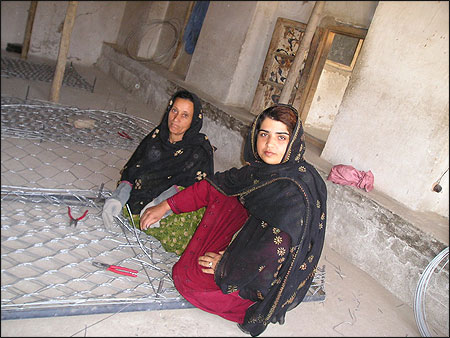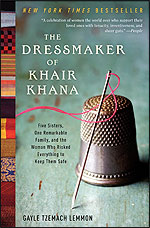
Barred from teaching after the Taliban took over Kabul, Afghanistan, Kamila Sidiqi, right, found another way to support her sisters. She is the subject of Gayle Tzemach Lemmon’s “The Dressmaker of Khair Khana.” Photo courtesy of Mercy Corps.
What do you do when the gatekeepers tell you it can't be done?
The answer: Go around them.
And if the old gatekeepers have lost power, then who are the new ones?
The answer: You.
When I began pitching the story of what would become my book "The Dressmaker of Khair Khana: Five Sisters, One Remarkable Family, and the Woman Who Risked Everything to Keep Them Safe," I met a slew of unmoved listeners. One New York literary agent luminary told me that if he had found "anything at all" in the story of an Afghan teenage woman—teacher-turned-entrepreneur—whose dressmaking business supported women across her neighborhood under the Taliban, he would tell me to pursue the book idea.
Unfortunately, he said, he did not. I swallowed, felt sorry for myself, and went to bed. And the next day I began again.
Believing in Your Story
What fascinated me as the pitch sessions continued was that men of a certain age would nearly always give me the same, certain reaction when I shared my idea: a bored yawn. Women of nearly any age would almost always ask me to tell them more.
I believed in the power of the dressmaker's story from the start. The tale of women who became breadwinners during years in which they were banned from their streets was only one extraordinary narrative I had encountered in my reporting, yet it stood for so many others. When men go off to fight, women battle for survival at home and make sure there is a place to return to when conflict ends. Their stories of daring, adventure and survival nearly always are ignored in a war narrative focused entirely on men.
Women go unseen and underestimated, and I sensed women had had enough of both. Telling the dressmaker's story could change that. It could do its small part to honor brave and quiet heroes who dare to make things better, every day, in all corners of the world, without waiting for help and against great odds. I could not know then that a deepening global recession would make the story of the power of one to create change even more resonant for many.
What I knew was that everyone who said there was no audience for this story was wrong. Not because I saw the future, but because I understood the present. When I talked with women on airplanes and in shopping malls and to girls on college campuses and in high school, I saw their excitement at hearing the story—and it inspired me to keep fighting. I kept every discouraging e-mail as fuel. I knew that if I could just get the story to women, they would find themselves in this story of resilience, faith and family.
Not long before the book's publication I met a senior publishing executive who told me rather politely that it was "not like" "The Dressmaker of Khair Khana" would be a bestseller so I should enjoy the process of publishing my first book. Hearing that made me more determined than ever to make it succeed.
Self-Marketing Push
In the run-up to publication of "The Dressmaker of Khair Khana," my editor, Julia Cheiffetz, at HarperCollins, the book's publicist, Heather Drucker, and I became rogue digital marketing agents, with assistance from Lisa Sharkey, who helped me bring the book to the publisher. Working as a team—combining the strength of our individual arenas of contacts and expertise—our strategy was to draw wide attention through mass media outlets and simultaneously target niche audiences of interest and influence.
I got in touch with former newsroom colleagues and friends at ABC News, who helped secure media bookings. Tina Brown and The Daily Beast, for whom I reported from Afghanistan, scheduled an excerpt. I called, e-mailed and tweeted within as many different networks as I could think of that would be natural audiences and allies for the book. Still, we wanted to reach out to more groups. Soon I was connecting with women in 85 Broads, the business network, and to development nonprofits such as Bpeace and Dining for Women. I got in touch with Harvard Business School, where I began my reporting for this book during my studies for a master's in business administration. We received support from Goldman Sachs's 10,000 Women, which reaches worldwide to serve underserved female entrepreneurs with business education, and the International Center for Research on Women. And I reconnected with the Thunderbird School of Global Management, which I mention in the book.
Meanwhile, Drucker pitched nonstop to radio and TV for interviews, to book bloggers and mom bloggers for posts about the book, and Julia built a network of women leaders who felt strongly that the dressmaker's story should be told. They became our champions, and soon, with them reaching their friends and contacts, our circles of influence expanded.
When book bloggers wrote about "The Dressmaker," I'd find out and reply quickly to let them know that I would gladly do a Q. and A. for their sites. When the online SITSGirls offered to make "The Dressmaker" their book club selection, we leapt at the chance. HarperCollins offered a book giveaway to the hip fashion site Modcloth, and Cheiffetz reached out to the online crafting powerhouse Etsy, where we hosted a Twitter discussion about the power of women entrepreneurs to create change. And when I met the very gracious (and wildly successful) author Deepak Chopra in a CNBC green room, Cheiffetz followed up by writing to see whether, given his belief in the power of women to change the world, he would be willing to tweet about "The Dressmaker." He was. And we were on our way.
Glittering reviews in places such as People and O Magazine were incredibly powerful, and so were readers who found out about the book online. Twitter was a potent engine for spreading the word and so were bloggers. My book was one of the first nonfiction bestsellers at HarperCollins in which the e-book outsold the hardcover.
By using social media effectively, the power was ours to quickly and directly connect with people as they'd hear about "The Dressmaker" on radio interviews or Facebook, for example. Homeschooling moms tweeted about the book, and I wrote back to let them know that their support made a difference—something that may have been a new experience for them and others who posted words about it. A pretzel entrepreneur in Chicago wrote to me on my website about how the book taught her that if a girl could start a business under the Taliban, she could surely work around obstacles she faced in her enterprise. Dads in Alaska posted on Facebook about how they hoped their daughters would share the dressmaker's values. And women booksellers would stop me at book events to say, "My boss was surely surprised you were a bestseller. I was thrilled to put your book on the shelf and show him he was wrong."
This was the right moment for a little story that could about an entrepreneur who never believed she could not. But that didn't alone guarantee its success. My job as its author was to keep in touch with the audience that had propelled us forward, the one who knew, as we did, that women's stories are war stories, too. These were people who knew stories like this one excite and inspire. Our army of champions—underestimated by many, connected by technology, and eager to be heard—enabled my book to succeed. And its success became theirs, too.
Gayle Tzemach Lemmon, author of "The Dressmaker of Khair Khana: Five Sisters, One Remarkable Family, and the Woman Who Risked Everything to Keep Them Safe," is a contributing editor at large at Newsweek and The Daily Beast. She is a fellow at the Council on Foreign Relations, where she serves as deputy director of its Women and Foreign Policy program. More of her work is at www.gaylelemmon.com and on Facebook; she tweets @gaylelemmon.




